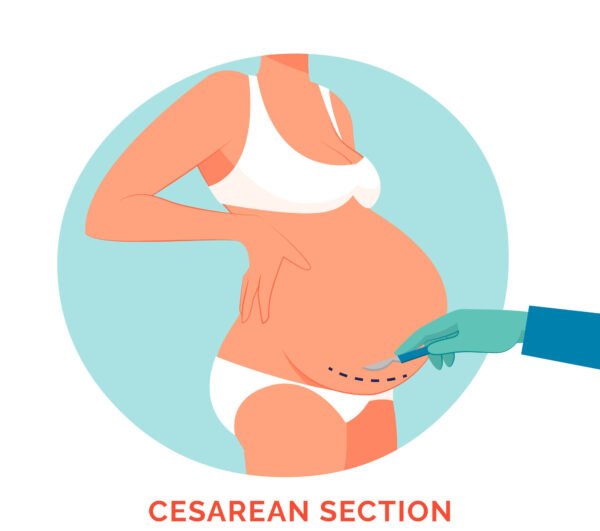Caesarean Section (C-Section): What to Expect, Benefits, and Recovery
A Caesarean section, commonly known as a C-section, is a surgical procedure used to deliver a baby through incisions made in the mother’s abdomen and uterus. While vaginal birth is the most common way to deliver a baby, C-sections are performed when it’s deemed safer for the mother, the baby, or both.
In recent years, C-sections have become more common, with many women opting for them due to medical reasons or personal preferences. Understanding the process, the reasons behind it, and what to expect during recovery can help you make an informed decision about your delivery plan.
Why Are C-Sections Performed?
There are several reasons a C-section may be recommended by your doctor, some planned in advance and others as emergency measures during labor. These include:
Medical Reasons for a C-Section:
- Fetal Distress: If the baby shows signs of distress, such as an irregular heartbeat, during labor, a C-section may be the safest option to ensure the baby’s well-being.
- Breech or Transverse Position: If the baby is in a breech (feet-first) or transverse (sideways) position, a C-section is often recommended, as vaginal delivery in these cases can be risky.
- Multiple Pregnancies: In cases of twins, triplets, or more, the risk of complications increases, and a C-section may be advised to ensure a safe delivery.
- Placenta Issues:
- Placenta Previa: If the placenta is covering the cervix, a C-section is necessary, as vaginal delivery could lead to severe bleeding.
- Placental Abruption: This is when the placenta detaches from the uterus prematurely, cutting off the baby’s oxygen supply.
- Maternal Health Conditions: Some maternal health conditions, such as diabetes, high blood pressure, or infections (like HIV or herpes), may make vaginal delivery unsafe.
- Prolonged Labor: If labor is progressing very slowly or not progressing at all, a C-section may be performed to avoid prolonged stress on both mother and baby.
- Previous C-Section: If a woman has had a C-section in the past, especially with a vertical incision, doctors may recommend a repeat C-section for future births, although vaginal birth after C-section (VBAC) is possible in some cases.
Types of C-Sections
- Planned C-Section: This is scheduled in advance, typically for medical reasons or by the mother’s choice. It allows both the mother and healthcare team to prepare for the procedure.
- Emergency C-Section: Performed when complications arise during labor that make vaginal delivery risky, an emergency C-section is unplanned and often happens quickly to ensure the safety of the mother and baby.
The C-Section Procedure
A C-section typically lasts between 45 minutes to an hour, with the baby being delivered within the first 10-15 minutes. The remaining time is spent closing the incision and completing the procedure.
Steps Involved:
- Preparation: The mother is given anesthesia—either a spinal block or an epidural—to numb the lower half of her body while remaining awake during the procedure. In rare cases, general anesthesia may be used, rendering the mother unconscious.
- Incision: A horizontal incision (also known as a bikini cut) is made in the lower abdomen, just above the pubic hairline. In emergency cases, a vertical incision may be made.
- Delivery: The surgeon makes a second incision in the uterus and carefully delivers the baby. Once the baby is born, the doctor cuts the umbilical cord and hands the baby to the healthcare team for evaluation.
- Placenta Delivery: After the baby is born, the doctor removes the placenta and begins closing the incisions in the uterus and abdomen.
- Recovery: The mother is taken to a recovery room where she is monitored for a few hours before being moved to her hospital room.
Benefits and Advantages of C-Sections
While C-sections are more invasive than vaginal births, they offer several benefits in certain situations:
- Safety for Complicated Pregnancies: In cases where vaginal delivery poses risks to the mother or baby, C-sections are often the safest option, reducing the chance of birth injuries or complications.
- Planned and Controlled: For planned C-sections, the process can be scheduled in advance, allowing the mother to prepare physically and mentally.
- Less Risk of Pelvic Floor Damage: C-sections reduce the risk of pelvic floor injuries, which can lead to issues like incontinence or prolapse later in life.
- Avoiding Prolonged Labor: In cases where labor is not progressing, a C-section can help avoid potential complications that come with prolonged labor, such as fetal distress or infections.
Recovery After a C-Section
Recovery from a C-section takes longer than recovery from a vaginal birth, as it is major abdominal surgery. Most women are able to go home within 3-4 days after the procedure, but full recovery can take several weeks.
What to Expect in the First Few Days:
- Pain and Discomfort: You’ll experience pain at the incision site, and pain medications will be provided to manage discomfort. Moving, coughing, and laughing may cause discomfort initially.
- Hospital Stay: After the surgery, you’ll spend a few hours in recovery where your vitals and incision will be monitored. You’ll also begin breastfeeding and bonding with your baby during this time.
- Walking and Activity: You’ll be encouraged to get up and walk around within a day to prevent blood clots and promote healing. However, strenuous activity and lifting heavy objects should be avoided for several weeks.
Post-C-Section Care Tips:
- Incision Care: Keep the incision clean and dry, and watch for signs of infection such as redness, swelling, or discharge.
- Rest: Rest is crucial for recovery. Limit physical activity and avoid lifting anything heavier than your baby for the first few weeks.
- Pain Management: Take pain medications as prescribed. Some women experience cramping as the uterus contracts back to its normal size.
- Support: Have a strong support system in place. Whether it’s family, friends, or a hired professional, having help with household tasks and baby care is essential.
Potential Risks and Complications of C-Sections
Like any surgery, C-sections carry certain risks, including:
- Infection: Both the incision site and the uterus can become infected.
- Blood Clots: There is a risk of developing blood clots in the legs or lungs.
- Hemorrhage: Excessive bleeding can occur during or after surgery.
- Longer Recovery Time: Recovery from a C-section takes longer than from a vaginal birth, with mothers requiring more rest and limited physical activity.
- Breathing Problems in Babies: Babies born via C-section may have temporary breathing issues, especially if delivered before 39 weeks.
Conclusion
A Caesarean section is a safe and effective way to deliver a baby when vaginal birth is not possible or advisable. While it is a major surgery, advances in medical care have made C-sections a common procedure with a high success rate. By understanding the reasons for a C-section, what to expect during the procedure, and how to manage recovery, you can feel more confident and prepared if a C-section becomes part of your birth plan.
It’s important to work closely with your healthcare provider to determine the best delivery method for your specific situation, ensuring the health and safety of both you and your baby.





